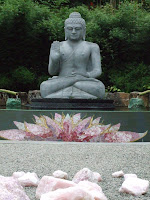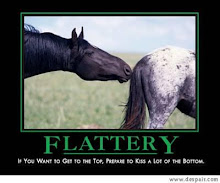 p our horses happy and healthy. Most of the time we get to talk to these guys every few weeks, or months, but the dentist may only come around once a year - so watch carefully, you never know what you might learn, and you have very little oppurtunity to do so!
p our horses happy and healthy. Most of the time we get to talk to these guys every few weeks, or months, but the dentist may only come around once a year - so watch carefully, you never know what you might learn, and you have very little oppurtunity to do so!Our new dentist came out yesterday to do about 5 horses on the property, I was crossing my fingers he'd be obliging and teach me a little as he worked. I was really in luck, and he was happy to not only talk about all sorts of stuff, but also to show me, let me feel and take a few pictures as well. I thought I'd share some of the interesting things we chatted about.
Here's the first guy, and we're looking at his canine tooth.
 Notice the redness around the base of the tooth? He's just had a lot of soft plaquey stuff removed from it ( you can still see the green tinge to the base of the tooth), the dentist tells me that some sorts of feeds - in general specific types of grasses - often leed to this build up of ick on the horse's canine teeth as they don't get the general abraision the rest do. The other point of interest in this horse's mouth is the small area of wear to his inner lip, mid-way between the canine and the tip of the dentist's thumb( it's a little tricky to see it in the photo, but pretty easy on the day). This little wear was due to the canine being very sharp at the tip, which would normally not be too much of a problem, except when you have a drop noseband on. The drop noseband will push into this area, causing the lips to bulge into the canine teeth, causing rubbing. This is a very mild case, but if left may have caused a nasty ulcer.
Notice the redness around the base of the tooth? He's just had a lot of soft plaquey stuff removed from it ( you can still see the green tinge to the base of the tooth), the dentist tells me that some sorts of feeds - in general specific types of grasses - often leed to this build up of ick on the horse's canine teeth as they don't get the general abraision the rest do. The other point of interest in this horse's mouth is the small area of wear to his inner lip, mid-way between the canine and the tip of the dentist's thumb( it's a little tricky to see it in the photo, but pretty easy on the day). This little wear was due to the canine being very sharp at the tip, which would normally not be too much of a problem, except when you have a drop noseband on. The drop noseband will push into this area, causing the lips to bulge into the canine teeth, causing rubbing. This is a very mild case, but if left may have caused a nasty ulcer.Pulling the lip out like this makes it easy to see if rub is occurring here, and if there is, remove your noseband and get your dentist to come out and have a look!
The next horse up a mare.
 Notice no canines are present, most mares don't have any, whilst the majority of male horses will have 4. Also notice how the incisor has a "hook" to it's rear. This little hook helps to define age, and will come and go at different stages in the horse's life. This particular horse is 7 1/2yo, and the developement of the hook is typical to that age, and should be gone before the dentist has a return visit in a year's time. It should also reappear around age 12, again being worn away about a year later.
Notice no canines are present, most mares don't have any, whilst the majority of male horses will have 4. Also notice how the incisor has a "hook" to it's rear. This little hook helps to define age, and will come and go at different stages in the horse's life. This particular horse is 7 1/2yo, and the developement of the hook is typical to that age, and should be gone before the dentist has a return visit in a year's time. It should also reappear around age 12, again being worn away about a year later.The last of the horse's of interest had what is called a TMJ (Temporal Mandibular Joint) problem, very mildly. This was evident when the dentist lightly rubbed a spot just beneath the horse's ear, to get a slight reaction of pain. He described to me a horse he had recently treated who had not seen a dentist for 5 years or more. This horse's pain had become so bad he was unable to be bridled, and eventually not able to be haltered, this horse had very BAD TMJ. The horse was a horror to treat and took about 20 minutes to get the gag on, but when it was all over, the horse was calm and was once again easy to halter. A week later there was no sign of there ever being a bridle issue, the jaws were able to relax and the pain gone.
TMJ happens when the molars are unable to meet up correctly because of uneven wear. Uneven wear can occur from a tooth being broken or a mis-shapen tooth or gum-line, with regular dental work these can be fixed, within reason, or at least be kept in check. These uneven points of wear will stop the horse from being able to relax its jaws properly, and causes tightness in the facial muscles that perform chewing motions. In people it can cause nasty head aches, and I can't imagine it would be any different for the horses!
Just by talking to the dentist while he did his work, I was able to gather lots of new information from him. Not only about my own horse, but about different things that can occurr to a horse in general, ways to see if it's happening and signs to look out for. These professionals have a wealth of information, they have both theoretical knowledge and plenty of hands on stuff too! Ask them questions, ask them to show you.... let them EDUCATE you so that you will be able to do better for your horses. Treat the cost of the visit as the price you pay for an invaluable lesson, not just the treatment. Look forward to the dentist's annual visit ( or more frequently for those babies and oldies) you never know what you will learn.


